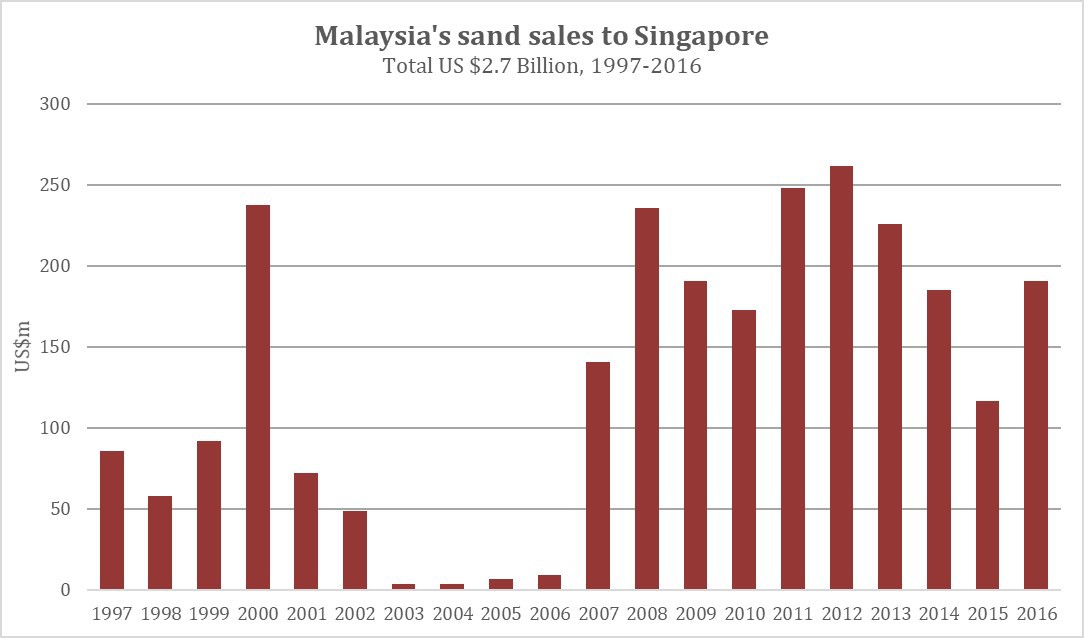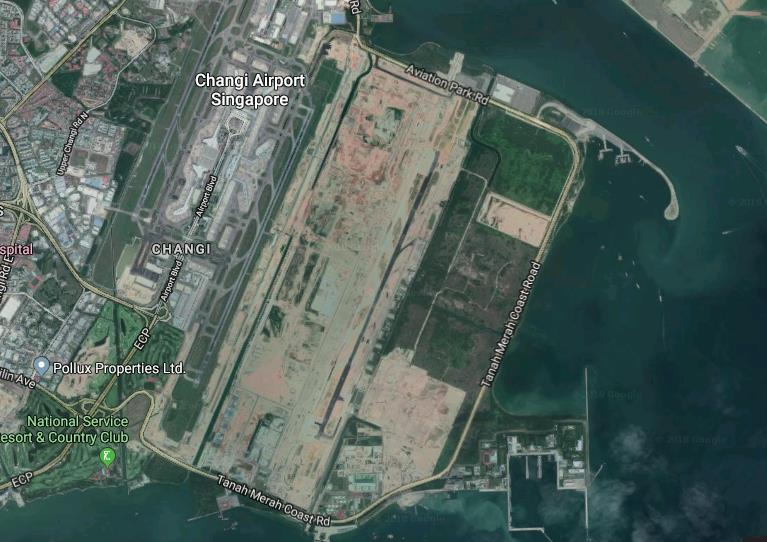MALAYSIA’S newly elected prime minister once said that illegal sand miners were “digging up Malaysia and giving her to other people.”
During his previous term in office, he tried to fix what he viewed as an aggressive assault on Malaysia’s heritage: the selling of its sand.
To put a stop to it, Mahathir imposed a sand export ban to Singapore in 1997, which at the time was reclaiming huge swathes of new land to expand its territory. That enterprise required vast amounts of sand unavailable to Singapore, but which could be easily found in its neighbour, Malaysia.
SEE ALSO: India hosts World Environment Day as its citizens drown in plastic
However, despite Mahathir’s best efforts to protect Malaysia’s environment, it appears the ban was at best only minimally effective, and in most years completely illusory.

Former Malaysian prime minister and opposition candidate Mahathir Mohamad celebrates with other leaders of his coalition during a press conference in Kuala Lumpur on early May 10, 2018. Source: Manan Vatsyayana / AFP
Yet the impression largely propagated by the media has been that Malaysia’s sand ban has been in place and enforced up until last year. In 2017, Malaysia’s Ministry of Natural Resources and the Environment announced that the sand ban had been lifted and that exports of sand would be permitted to Singapore on a case-by-case basis.
But that was rather an odd announcement considering UN Comtrade reports filed by Malaysia and Singapore over nearly twenty years that appeared to contradict the suggestion that the ban had ever been in place at all.
A recent review of Malaysia’s “stone, sand and gravel” exports to Singapore and Singapore’s purchases of those resources over two decades suggests that Mahathir’s sand ban, initiated to protect a fragile Malaysian environment, was seemingly ignored, including by his own government.
For most of those years, except for a relatively brief four-year period between 2003 and 2006, the ban appeared to be ineffectual.
For example, Malaysia reported to UN Comtrade that Singapore bought US$58 million worth of “stone, sand and gravel,” or over $9 million per year on average, between 1997 – the first year of Mahathir’s ban – and 2002.
However, Singapore reports it spent $595 million during this same period, or nearly ten times what Malaysia claims. The amount of materials exported by Malaysia to Singapore during this period don’t indicate any kind of functional ban.

Source: UN Comtrade, Singapore report
It’s possible the ban was slow in getting started. But in 2003, the year Mahathir left office, exports of materials from Malaysia to Singapore do, in fact, radically and quickly slump — at long last.
During this period, Singapore reported purchases of $24 million; Malaysia reported exports of $7 million. These much-reduced amounts of imports and exports do, in fact, suggest that Mahathir’s ban was at last being observed, but there may be a specific reason for this.
According to Singapore’s reports to UN Comtrade, in 2003 it began buying huge quantities of “stone, sand and gravel” from Indonesia.
SEE ALSO: Laos pushes ahead with Mekong dams despite environmental risks
Over the four years between 2003 and 2006, Singapore reports that it purchased a total of $338 million worth. This is the same time period that Malaysia’s exports of these same materials to Singapore precipitously dropped. In other words, the level of these new imports from Indonesia effectively replaced the annual amount of sand Singapore had been acquiring from Malaysia.
Unsurprisingly, by 2007, Indonesia had announced its own export ban of sand to Singapore, citing environmental concerns after the active sand extraction caused islands to start disappearing.
But, despite both Malaysia and Indonesia placing bans, the stream of “stone, sand and gravel” exports continued to flow.

Source: UN Comtrade, Singapore report
In the final years of Abdullah Ahmad Badawi’s premiership, between 2007 and 2009, Malaysia sold Singapore about $568 million worth of the product.
By 2010, the first year of Najib Razak’s leadership, sales to Singapore came in at $173 million, at least as reported by Singapore. And amazingly, over the next six years, Singapore reported buying a total of $1.2 billion in exports of this kind from Malaysia. In total, that’s a shocking $2 billion of sales to Singapore between 2007 and 2016.
It’s safe to say that’s no ban at all.
SEE ALSO: Malaysian environmentalists call for halt to Chinese-funded rail project
Is it possible that Singapore was purchasing stone and gravel, and not sand? Perhaps.
The UN Comtrade makes no distinction between these materials. But it seems unlikely at best, especially since Singapore would have spent $3 billion of public funds on just “stone and gravel” from both Malaysia and Indonesia in about ten years. That’s approximately $300 million a year on stones alone.
It also ignores the obvious. Between 1992 and 2004, Singapore was engaged in reclaiming vast tracts of new land. These areas included 2,000 hectares at Changi East and 3,000 hectares at Jurong Island. In addition, it was building public beaches and large waterfront areas at its Southern Islands.

The Changi East Reclamation Project in Singapore, a multi-phase project involving the formation of 2000 ha of land by placing hydraulically filled sand on to soft seabed marine clay. Source: Google Maps
During this period, Singapore’s appetite for sand was voracious as 5,000-plus hectares of new land requires hundreds of millions of tonnes.
But whatever the quantities, Malaysia’s and Indonesia’s professed sand bans appeared to be disingenuous. It may have been the media’s reiteration of the existence of these bans that helped perpetuate the public perception that these bans were in place, but the UN Comtrade statistics tell a completely different story.
Vietnam tells a similar story. In 2009, the Southeast Asian nation also announced a ban on sand exports to Singapore. But again, the numbers show a different reality.
Between 2009 and 2016, Singapore bought $756 million of “stone, sand and gravel” from Vietnam. Only two years – 2011-2012 – show a substantial drop in imports by Singapore. Otherwise, it appears to be business as usual.
Given these huge sums over ten years, Vietnam can hardly be said to have implemented any kind of comprehensive ban at all. Curiously, there are significant discrepancies in the values reported by each country. While Singapore claims it purchased $756 million, Vietnam only reports a sale of $126 million over the same period.
Evidence suggests that these sand bans are, in effect, no ban at all, at least in any meaningful sense.
SEE ALSO: Vietnam: Climate change, dams will drastically impact Mekong region
What’s of grave importance is the damage still being done to Malaysia’s coasts and rivers, as well as those of Indonesia, Vietnam, and other Southeast Asian nations, due to incessant sand mining.
That’s the real story in UN Comtrade’s statistics.
If the sand mining continues and there are no effective multi-state sand mining bans put into place, the region will gradually lose their natural heritage and endanger native wildlife.
So perhaps now that Mahathir’s back in office, he will lead the way in Southeast Asia and demand a genuine sand ban in the name of Malaysia’s environment.
Clearly with everything we know of the intensely destructive impact that sand mining has on seashores, rivers, and inlands, Malaysia’s long-term environmental protection should be one of Mahathir’s top priorities.
Piyali Banergee is the lead writer and researcher for Nature Watch, an environmental watchdog group working in various parts of Asia to protect rivers and coasts.





